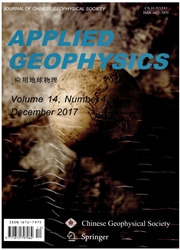

 中文摘要:
中文摘要:
有在频率空间(f-x ) 滑动窗口的一个噪音减小方法域,调用了本地 f-x Cadzow 噪音减小方法,在这份报纸被介绍。当随机的噪音不是时,这个方法基于在每扇窗户中的信号在空间方向是线性地可预言的假设。为经常的频率片构造的每个 Toeplitz 矩阵,单个值分解(SVD ) 被使用把信号与噪音分开。为了避免边人工制品,由在窗户之间并且到的百分之零重叠引起了移开更多的噪音,适当重叠被采用。除扁平、蘸的事件以外,这个方法能提高弯并且冲突事件。然而,它不对包含大尖铁或空踪迹的地震数据合适。它也与在窗户外面的 SVD, f-x deconvolution,和 Cadzow 方法相比。比较结果证明本地 Cadzow 方法表现很好在移开随机的噪音并且保存信号。另外,一个真实数据例子证明它是为在复杂形成的区域获得的地震数据的一种潜在的噪音减小技术。
 英文摘要:
英文摘要:
A noise-reduction method with sliding called the local f-x Cadzow noise-reduction method, windows in the frequency-space (f-x) domain, is presented in this paper. This method is based on the assumption that the signal in each window is linearly predictable in the spatial direction while the random noise is not. For each Toeplitz matrix constructed by constant frequency slice, a singular value decomposition (SVD) is applied to separate signal from noise. To avoid edge artifacts caused by zero percent overlap between windows and to remove more noise, an appropriate overlap is adopted. Besides flat and dipping events, this method can enhance curved and conflicting events. However, it is not suitable for seismic data that contains big spikes or null traces. It is also compared with the SVD, f-x deconvolution, and Cadzow method without windows. The comparison results show that the local Cadzow method performs well in removing random noise and preserving signal. In addition, a real data example proves that it is a potential noise-reduction technique for seismic data obtained in areas of complex formations.
 同期刊论文项目
同期刊论文项目
 同项目期刊论文
同项目期刊论文
 期刊信息
期刊信息
